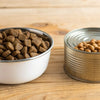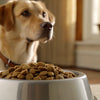Is Dry or Wet Dog Food Better for Puppies? A Comprehensive Guide for New Pet Owners
- Houndsy
Table of Contents
- Introduction
- Understanding the Nutritional Needs of Puppies
- The Nutritional Advantages of Wet Food for Young Pups
- The Benefits of Dry Dog Food for Puppies
- Making the Right Choice for Your Puppy
- How to Introduce Wet Food to Your Puppy
- Addressing Hydration Needs Through Wet Food
- Potential Drawbacks of Wet Food
- Conclusion
- FAQs
Introduction
Did you know that over 70% of dog owners experience confusion when deciding what food to feed their pets? This statistic resonates deeply with us as pet lovers and guardians, especially during the crucial early months of our puppies’ lives when their dietary choices can significantly affect their growth, health, and happiness.
Puppies, much like human infants, have specific nutritional requirements that must be met to support their rapid development. As they transition from their mother’s milk to solid food, the question arises: is dry or wet dog food better for puppies?
In this blog post, we aim to explore this essential topic to help you make informed decisions about your puppy’s diet. We will delve into the nutritional differences between dry and wet food, discuss the benefits and drawbacks of each, and provide tips on how to choose the best option for your furry friend. By the end of this comprehensive guide, we hope you will feel more equipped to enhance your puppy's feeding experience while considering their unique needs.
Let’s embark on this journey to uncover the best feeding practices for our beloved puppies!
Understanding the Nutritional Needs of Puppies
The Importance of Proper Nutrition
Puppies undergo rapid growth and development, requiring a diet rich in essential nutrients. This includes protein for muscle growth, fats for energy, and a range of vitamins and minerals to support their overall health. The right nutrition during these formative months sets the foundation for a strong, healthy adult dog.
Unique Nutritional Requirements
- Protein: Puppies need more protein than adult dogs to support muscle development and energy.
- Fats: Healthy fats are essential for brain development and energy.
- Calcium and Phosphorus: These minerals are crucial for developing strong bones and teeth.
- Vitamins: Vitamins like A, D, E, and B complex help with various bodily functions, including immune health and metabolism.
As we consider whether dry or wet dog food is better for puppies, it's crucial to ensure that whichever option we choose meets these nutritional standards.
The Nutritional Advantages of Wet Food for Young Pups
Higher Moisture Content
Wet dog food typically contains around 60% to 84% moisture, making it an excellent option for puppies who may not drink enough water. This added hydration can be beneficial, especially for those with urinary or kidney health concerns.
Palatability and Appeal
Puppies are often drawn to the aroma and texture of wet food, which can be more enticing than dry kibble. This can be particularly helpful for picky eaters or those who may be recovering from illness and need encouragement to eat.
Easier to Chew
With their developing teeth, puppies may find wet food easier to chew and digest compared to dry kibble. The soft texture can help prevent any unnecessary strain on their teeth and gums.
Nutrient Density
Wet food often contains higher levels of protein and fat, which can be advantageous for growing puppies. The quality of ingredients in premium wet foods can also provide essential nutrients in a more concentrated form.
The Benefits of Dry Dog Food for Puppies
Dental Health Benefits
One of the notable advantages of dry food is its potential to support dental health. The crunchy texture of kibble can help reduce plaque and tartar buildup, promoting healthier teeth and gums.
Convenience and Storage
Dry dog food is generally easier to store and feed. It has a longer shelf life compared to wet food and can be left out without spoiling, making it a convenient option for pet owners who may not have time to feed their puppies multiple times a day.
Cost-Effectiveness
Dry kibble typically offers a more economical feeding option, especially for larger breeds or multiple pets. The concentrated nutrition in dry food means that smaller portions can still provide the necessary nutrients.
Versatility
Dry food can be easily incorporated into feeding puzzles and slow feeders, promoting cognitive stimulation and slowing down fast eaters. This can enhance your puppy's feeding experience and help prevent issues related to gulping food.
Making the Right Choice for Your Puppy
Factors to Consider
- Age and Size: Puppies have unique needs based on their breed and developmental stage. Larger breeds may require different nutritional balances than smaller breeds.
- Health Concerns: If your puppy has specific health issues, such as dental problems or hydration needs, this may influence your choice of food.
- Personal Preference: Some puppies may simply prefer one type of food over another. Observing your puppy's reactions to different foods can be helpful in making your decision.
Mixing Wet and Dry Food
An option that many pet owners find beneficial is mixing wet and dry food. This approach can provide the advantages of both types, ensuring your puppy gets the hydration from wet food while benefiting from the dental health properties of kibble.
How to Introduce Wet Food to Your Puppy
Gradual Transition
When introducing wet food to your puppy, it’s essential to do so gradually. Start by mixing a small amount of wet food with their current dry kibble. Over several days, increase the ratio of wet food while monitoring for any signs of digestive upset or allergies.
Establishing a Routine
Setting consistent mealtimes can help create a routine for your puppy. This predictability can promote better eating habits and a more enjoyable feeding experience.
Monitor Reactions
Keep an eye on your puppy's response to new food. If they show any signs of allergies, such as itching or gastrointestinal upset, consult your veterinarian for advice on dietary adjustments.
Addressing Hydration Needs Through Wet Food
Importance of Hydration
Hydration is crucial for your puppy's overall health, especially as they grow and develop. Wet food can provide an additional source of fluids, helping to keep your puppy hydrated and potentially preventing health issues related to dehydration.
Tips for Encouraging Drinking
- Fresh Water: Always provide fresh water alongside their meals.
- Flavor Enhancers: Consider adding a splash of low-sodium broth to their water to make it more appealing.
- Wet Food as a Mixer: Mixing a small amount of wet food with dry kibble can encourage your puppy to drink more water.
Potential Drawbacks of Wet Food
Dental Health Concerns
While wet food offers many benefits, it lacks the dental health advantages of dry kibble. Puppies that consume only wet food may be at a higher risk for dental issues, making it crucial to maintain dental hygiene through regular brushing or dental treats.
Cost and Storage Limitations
Wet food can be more expensive than dry kibble and generally has a shorter shelf life once opened, requiring careful storage and timely feeding to prevent spoilage.
Messiness
Feeding wet food can be messier than dry kibble, potentially leading to spills and requiring more frequent clean-up.
Conclusion
In the ongoing debate of whether dry or wet dog food is better for puppies, there is no one-size-fits-all answer. Each option offers unique benefits that can cater to different needs and preferences. Ultimately, the best choice will depend on your puppy's individual requirements, lifestyle, and your preferences as a pet owner.
As we at Houndsy continuously strive to enhance the pet feeding experience, we encourage you to explore our Houndsy Kibble Dispenser, designed to make feeding convenient and aesthetically pleasing. With our dispenser, you can ensure your puppy gets perfectly portioned meals every time, combining functionality with beautiful design.
We invite you to take a closer look at how the Houndsy Kibble Dispenser can elevate your puppy's feeding routine. Order Now and make mealtime an enjoyable experience for both you and your furry friend!
FAQs
Is wet food necessary for puppies?
While it’s not strictly necessary, wet food can provide hydration and be easier for puppies to chew, making it a beneficial addition to their diet.
Can puppies eat dry food only?
Yes, puppies can thrive on a high-quality dry kibble diet as long as it meets their nutritional requirements.
Do I have to wet my puppy's food?
You don't have to, but moistening dry kibble can help make it easier for young puppies to eat.
Can I feed my dog just kibble?
Absolutely, as long as the kibble is nutritious and balanced for your puppy's life stage.
Choosing the right food for your puppy is a critical decision that can impact their health and happiness for years to come. Whether you opt for wet, dry, or a combination of both, the key is to ensure that your chosen food meets their nutritional needs while fitting into your lifestyle.












